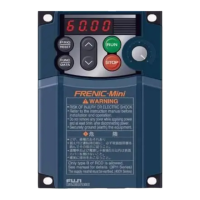8-38
8.7.2 Operation by external signal inputs
The basic connection diagram below shows an example for operation by external input signals.
(Note 1) Install a recommended molded case circuit breaker (MCCB) or a residual-current-operated protective device
(RCD)/earth leakage circuit breaker (ELCB) (with overcurrent protection) in the primary circuit of the inverter to
protect wiring. Do not use an MCCB or RCD/ELCB whose capacity exceeds the recommended rated current.
(Note 2) A magnetic contactor (MC) should, if necessary, be mounted independent of the MCCB or ELCB to cut off the
power fed to the inverter. Refer to Chapter 6, Section 6.3. [ 1 ] for details. MCs or solenoids that are to be installed
close to the inverter require connecting surge absorbers in parallel to their coils.
(Note 3) When connecting a DC reactor (option), remove the jumper bar from terminals [P1] and [P+]. Refer to Chapter 6,
Section 6.3. [ 2 ] for details.
(Note 4) The THR function can be used by assigning "9" (External alarm) to any of terminals [X1] to [X3], [FWD] or [REV]
(function code E01 to E03, E98, or E99). For details, refer to Chapter 9.
(Note 5) Frequency can be set by connecting a frequency setting device (external potentiometer) between terminals [11], [12],
and [13] instead of inputting voltage signal (0 to +10 VDC or 0 to +5 VDC) between terminals [12] and [11].
(Note 6) For the wiring of the control circuit, use shielded or twisted wires. When using shielded wires, connect the shields to
earth. To prevent malfunction due to noise, keep the control circuit wiring away from the main circuit wiring as far
as possible (recommended: 10 cm or longer), and never set them in the same wire duct. When crossing the control
circuit wiring with the main circuit wiring, set them at right angles.
(Note 7) A three-phase 4-wire cable is recommended for motor wiring to reduce the noise emitted. Connect the motor
grounding wire to the inverter grounding terminal
G.
The basic connection diagram above is for running/stopping the inverter and setting the frequency
with external signals. Given below are connection notes.
(1) Set function code F02 to "1" (External signals).
(2) Set function code F01 to "1" (Voltage input to terminal [12]) or "2" (Current input to terminal
[C1]).
(3) Short-circuit terminals [FWD] and [CM] to run the motor in the forward direction and opening
them to stop it. Short-circuit terminals [REV] and [CM] to run the motor in the reverse direction
and opening them to stop it.
(4) Frequency by voltage input is within the range from 0 to +10 VDC or 0 to the maximum
frequency. Frequency by current input is within the range from +4 to +20 mADC or 0 to the
maximum frequency.
* With a built-in terminating resistor
switch

